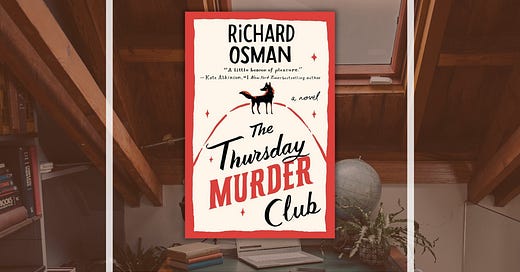Coming up on The Writer’s Attic…
A Book Belongs Only To Its Writer: an in-depth reflection on how to approach revision in a way that honors your creative vision.
The Book Breakdown: a new series in which we break down the elements of a published novel in order to discuss what makes it a good book, so we can sharpen our skills as storytellers.
“And, that, believe it or not, was the first I had heard of Thursdays.”
Welcome to 5-Page Book Club, in which we read five pages of a novel to see what we can learn as writers. This feature is for paid subscribers; free subscribers get a short preview. Next week’s post will be free.
Today, let’s discuss five pages of Richard Osmond’s The Thursday Murder Club, a cozy mystery novel featuring four friends who live in a retirement village and meet every Thursday to solve murders. The book is very popular—it sold upwards of 1 million copies in the same year as its release (2020)! And Netflix will soon air a film adaptation.
You can read the first five pages of The Thursday Murder Club here for free.
The Voice Is Charming
With so many cozy mysteries on shelves, an author has to find a way to make his own stand out. The Thursday Murder Club does this by immediately establishing a unique voice. The first chapter is told by Joyce, who is about to become a member of a secret mystery-solving club at her retirement home.
Joyce starts by telling us about another member of the club, Elizabeth. This is how Joyce knows Elizabeth:
I was once on a quiz team with Stephen, who, for a number of reasons, is Elizabeth's third husband.
Something about the phrase “for a number of reasons” makes me chuckle every time I read it. Joyce is a charming narrator who often makes amusing asides, qualities which make her instantly sympathetic. She’s also very relatable. For example, she comments on how confusing it is to have so many different-colored recycling bins in their retirement village. This is how I feel every time I’m staring into those separated bins at Starbucks (or are those only used in California?).
But Joyce isn’t just a sweet old lady. The novel opens with Elizabeth asking her a rather dark question:
Elizabeth said she could see that I was eating, but she wanted to ask me a question about knife wounds, if it wasn't inconvenient?
The politeness with which this question is relayed makes it another chuckle-out-loud moment for me. Mentions of murder and violence seem out of place in the lunchroom of a retirement village, but we soon learn why Joyce is just the person to answer this question: she used to be a nurse.
I have seen a lot of stab wounds in my time. My job wasn't all sprained ankles.
Now we get a bit of depth to Joyce, along with a compelling reason to follow her through a murder mystery. She knows about wounds; she’s smart and capable and unflappable. A sleuth we can admire.
Most importantly, her voice comes through in this section—a charming, funny, and sharp voice that doesn’t sound like every other character in the genre. In fact, even those who aren’t usually mystery readers are likely to be drawn in by Joyce’s narration.
The Narrative Style Invites Us Into The Club
The real fun of these opening pages is in learning we’re about to join The Thursday Murder Club (vicariously, through Joyce). In fact, the novel is just as much about the friendship of four amateur sleuths as it is about a murder investigation, which is why I think the series is so popular. It’s fun for mystery readers and it’s fun for people who don’t usually read mysteries but just enjoy a story about friendship told by charming narrators.
In the first chapter, Joyce gives us a snapshot of different members of the club (“Elizabeth knows everything,” “And that’s Bernard for you”). Not only that, but the author uses a nice narrative trick to make readers feel that we too are in the club:






